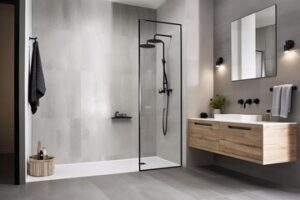Cabinet Refacing Sacramento is like a facelift for your cabinets. The installer removes the doors and drawer fronts, then cleans and sands them before applying a new veneer. The existing cabinet boxes stay in place, so the layout is unchanged.

Refacing is less expensive than full replacement but doesn’t address structural or design problems. Saving up for a complete kitchen renovation may be a better long-term strategy.
Cabinet refacing involves covering the existing cabinet frames and doors with a new material. It’s an environmentally-friendly option that uses less wood and is less expensive than a complete renovation. Choosing the right materials for your cabinet refacing project is critical to its success and durability. There are many options available, including solid wood, veneers, and plastic laminates. Each has its own benefits and drawbacks.
Solid wood is a popular choice for kitchen cabinet refacing because of its natural beauty and warmth. It’s also easy to customize and stain with a variety of colors and finishes. However, it can be vulnerable to moisture and requires regular maintenance with special oils and polishes.
Laminate is another common material used for cabinet refacing because it offers a wide variety of color and pattern options, including designs that mimic the appearance of natural stone. It’s also affordable and low-maintenance. However, it’s not as durable as solid wood or veneers and can easily chip or peel if exposed to excessive heat.
Rigid thermofoil (RTF) and plastic laminates are budget-friendly cabinet refacing materials that offer an array of design choices, including faux-wood styles. These options are resistant to heat and moisture, making them an excellent choice for high-moisture spaces like bathrooms. They’re also easier to clean than solid wood and don’t require sanding before painting.
The type of cabinet refacing materials you choose will impact the final cost of your project. The price of materials will vary based on their quality, with higher-quality materials typically costing more. Additional factors that can affect the final cost include the size of your kitchen and the number of cabinets you’re refacing.
While you can do a basic cabinet refacing yourself, it’s best to work with professionals to ensure high-quality results. A professional will use proper tools, have experience working with the chosen materials, and provide detailed instructions. Additionally, they will help you choose the best material for your unique aesthetic, functional needs, and budget. They’ll also guide you through the process of selecting a finish and hardware that will complement your new look.
Installation
Cabinet installation is a crucial aspect of home improvement, offering homeowners with storage solutions that are tailored to their individual needs and preferences. While DIY cabinet refacing can offer substantial cost savings, there are also some scenarios where hiring a professional handyman is the better choice. In this article, we will explore the benefits of enlisting professional help with cabinet refacing, from saving time to ensuring quality results.
In addition to enhancing the visual appeal of kitchen cabinets, cabinet refacing can also improve their functionality. By changing the hardware or installing soft close hinges and drawer glides, homeowners can improve the ergonomics of their cabinetry. This will make them easier to open and close, while reducing the risk of accidental damage or injury.
The installation process for cabinet refacing involves several steps, starting with assessing and evaluating the condition of the existing cabinets. This will ensure that they are structurally sound and suitable for refacing. Next, a professional will take precise measurements to ensure that the new doors and drawer fronts fit correctly during installation. They will also determine the best materials for the project, considering factors like durability and aesthetic.
Once the design plan is in place, the contractor will begin removing the old doors and drawer fronts. They will then sand the cabinet boxes to create a smooth surface for the installation of the new veneer or laminate. Then, the installer will install the new doors and drawer fronts, choosing from a wide selection of styles, finishes, and colors. The last step is adding the new hardware, which will complete the project and enhance its visual appeal.
Hiring a professional to handle the cabinet refacing project can save homeowners a significant amount of time and stress. The experience of a contractor will allow them to navigate unforeseen challenges and complications, ensuring that the project is completed on schedule and within budget. In some cases, a professional may even offer additional services to complement the cabinet refacing work. These can include repairs, organizational upgrades, and other improvements that can boost the overall value of the kitchen.
Finishing
Cabinet refacing is the process of upgrading every finished surface of your cabinets, including the doors and drawer fronts, without changing their layout. This is the best choice for homeowners who want to change the look and style of their kitchen but are not interested in a full remodel. The process is more cost-effective and takes less time than a complete kitchen remodel, making it ideal for a quick refresh.
There are several different materials that can be used for refacing your cabinets. One of the most popular choices is wood veneer, which comes in a variety of species and finishes. Wood veneer is a good option for homeowners who value natural beauty and durability. Another popular material is laminate, which is available in a wide range of colors and patterns. Laminate is durable and easy to clean, which makes it a great option for high-traffic areas like the kitchen.
Thermofoil is another popular choice for refacing cabinetry. It is made of a thin plastic film that is coated with a woodgrain pattern and then bonded to existing cabinet frames and doors. Thermofoil is a cost-effective option for refacing cabinetry, and it is also easy to clean.
If you choose to reface your cabinets, it’s important to match the new material with your countertop and backsplash. This will help to create a consistent, cohesive look in your kitchen. In addition, refacing your cabinets can help to increase the resale value of your home.
When it comes to choosing a professional company to handle your cabinet refacing project, you need to find one that has experience and expertise in the field. An inexperienced contractor may make mistakes that could cost you a lot of money in the future. It’s also important to find a company that offers a warranty on their work.
Cabinet refacing is a great way to update your kitchen without breaking the bank. By choosing a new door style, color, and hardware, you can transform your kitchen into a vision of modern elegance. However, it’s important to remember that refacing doesn’t address issues with your cabinet’s structural integrity. It is also not a good option for kitchens with outdated electrical wiring or plumbing problems, which can pose safety risks for your family.
Maintenance
When choosing a cabinet refacing company or contractor, look for a reputable name with a history of delivering high-quality results. Reading online reviews and requesting recommendations from friends can help you find the best option for your needs. Make sure that they offer a design consultation and provide you with a detailed written estimate of the project scope and associated costs. Additionally, verify their licenses and certifications to ensure that they comply with local regulations and industry standards.
After the refacing project is complete, it’s important to properly maintain your new cabinets in order to extend their lifespan and preserve their appearance. Incorporating regular cleaning sessions into your routine can prevent stains, grease build-up, and dust from damaging cabinet surfaces. It’s also a good idea to keep an eye out for signs of damage and wear, such as scratches or warping, and address them promptly to minimize the risk of more serious problems.
As a general rule, it’s best to use a mild detergent rather than harsh or abrasive cleaners, as these can damage the surface of your cabinets. You should also avoid using wax or polish, as these can build up and dull the finish over time. It’s also important to protect your cabinets from moisture, steam, cooking smoke, and excess heat to avoid warping or discoloration.
Another option for updating your cabinets is to paint or stain them. This is a relatively inexpensive and straightforward process that can be carried out by most homeowners. However, it’s essential to choose a high-quality product that is designed for cabinetry and is applied correctly by a trained professional.
Refacing is an excellent choice for a kitchen or bathroom renovation, and it typically offers a much faster turnaround than a full cabinet replacement. The fact that the cabinet framework remains intact makes it a more environmentally friendly solution, and you won’t have to deal with the disruption of a lengthy construction project. Furthermore, refacing keeps your kitchen in working order and eliminates the need for new plumbing, electrical, or gas connections, which can add significant cost and delay the completion of your project.
